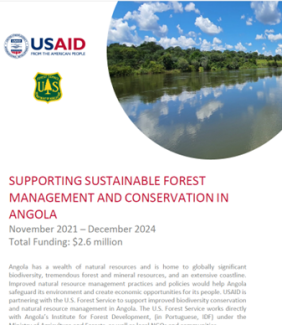November 2021 – December 2024
Total Funding: $2.6 million
OVERVIEW
Angola has a wealth of natural resources and is home to globally significant biodiversity, tremendous forest and mineral resources, and an extensive coastline. Improved natural resource management practices and policies would help Angola safeguard its environment and create economic opportunities for its people. USAID is partnering with the U.S. Forest Service to support improved biodiversity conservation and natural resource management in Angola. The U.S. Forest Service works directly with Angola’s Institute for Forest Development, (in Portuguese, IDF) under the Ministry of Agriculture and Forests, as well as local NGOs and communities.
The U.S. Forest Service activities complement the efforts of other institutions and programs, such as the USAID/Southern Africa Resilient Waters Program, the National Geographic Okavango Wilderness Project, and The Nature Conservancy Okavango Basin Program, which aims to support the ongoing initiatives in that region.
ACTIVITIES
1. National Forest Inventory technical support
USAID and the U.S. Forest Service provide training and tools like Geographic Information Systems (GIS) as well as innovative data to advance the Angolan forest inventory, which was initiated in a collaboration between the Government of Angola through the Institute of Forest Development and the Food and Agriculture Organization (FAO/UN). Forest inventories inform sustainable forest management decision making.
2. Community forestry pilot
USAID and U.S. Forest Service help local NGOs establish native species nurseries that support sustainable community forest management and forest restoration. We collaborate with Angolan NGOs such as ACADIR, Mbakita, Uvanje, along with ADPP and the KUVATA Cooperative on pilot scale projects in Cuando Cubango, Cabinda, Huambo and Huíla provinces. These pilots serve as demonstration sites for implementing new forest legislation and non-timber forest product livelihoods, such as thatch, honey and mushrooms.
3. Fire management capacity assessment
Completed an institutional and community-level wildlife management assessment which provides an overview of the country’s capacity. The assessment informs USFS technical assistance in Angola, considering local context, challenges and recommendations.
4. Protected area network assessment
Evaluated the protected area network in Angola, including historical challenges and unmet opportunities. The assessment informs USFS-supported interventions.
EXPECTED ACCOMPLISHMENTS
- Informed decision-makers using a reliable National Forest Inventory, with a strong understanding of the gaps and opportunities for forest management in Angola
- Established native species nurseries that are guided by good practice documents and led by local NGOs and communities
- Gaps and opportunities for improving Angola’s Protected Areas Network identified
- Improved sustainable management of forests and use of non-timber products by NGOs and local communities

